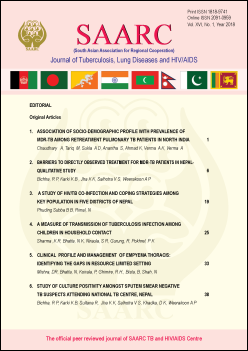A Study of HIV/AIDS Co-Infections and Coping Strategies of Key Population of Nepal
DOI:
https://doi.org/10.3126/saarctb.v16i1.23240Keywords:
Key study population, HIV/TB co-infection, stigma/discriminationAbstract
Introduction: Nepal is considered as a concentrated HIV epidemic among key population like Migrant Labour Worker (MLW), Sex Worker (SW), Injecting Drug User (IDU) and Spouse of Migrant Labour Worker (SMLW). Hence, the HIV infection has significantly contributed to be HIV/TB co-infected among key population. Intervention of Anti Retroviral Therapy (ART) and Direct Observed Short Course (DOTS) have significantly reduced HIV associated morbidity and mortality in Nepal. The objective of this study was to analyze coping strategies to access the HIV/TB services in relation to socio-economic status of key study population.
Methods: The study was conducted in five districts Jhapa, Morang, Sunsari, Kavre and Parsa of Nepal. The HIV/TB respondents were selected from previous background of key population: MLW, SW, IDU, and SMLW. 343 respondents were selected through snowballing and convenient sampling technique. The data were collected through face to face interview using pretested questionnaire. Descriptive statistics, Chi-square, and ANOVA test were applied to analyze the collected data.
Results: Among 343 HIV/TB co-infected respondents, more than two fifth (44.3%) were belonged to MLW, followed by one third (34.1%) of respondents were SMLW. Therefore, the HIV/TB co-infection was significant association (p=0.001) with employment status and key study population. In addition to this, the study showed that there was significant difference between facing stigma/discrimination and study districts (F=11.03, p=0.001) of respondents. Similarly, there was significant difference between used of previous saving and occupation of family (F=10.461, p=0.001) as coping strategies to access HIV/TB services.
Conclusion: Despite the existing stigma and discrimination, the key study population had used various coping strategies to access the health care services in relation to their socio-economic status.
Downloads
Downloads
Published
How to Cite
Issue
Section
License
Copyright © SAARC Tuberculosis and HIV/AIDS Centre (STAC), all rights reserved, no part of this publication may be reproduced, stored in a retrieval system or transmitted in any form or by any means without prior permission of the STAC.





